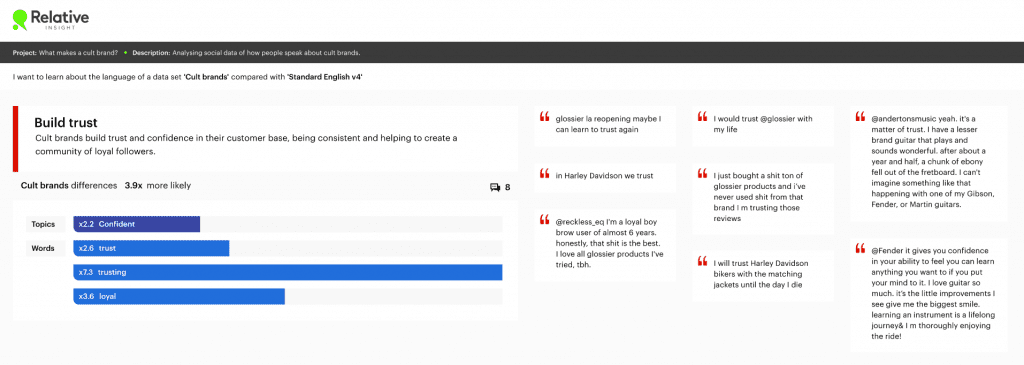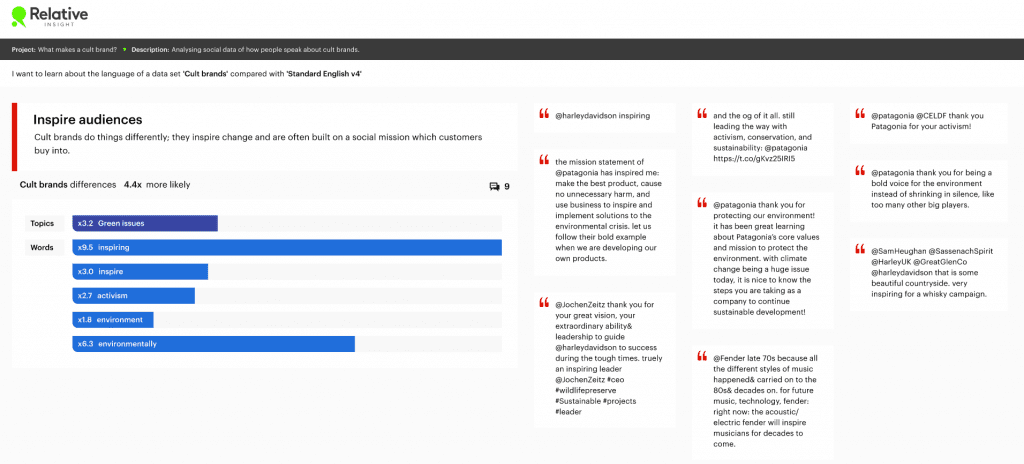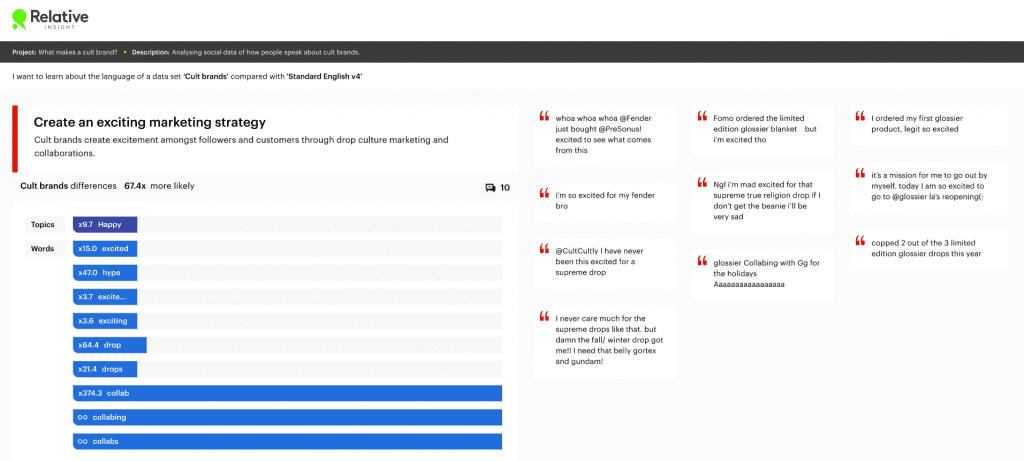How to build a cult brand

“Cult” – defined by OED as a way of life, an attitude or an idea that has become very popular.
For brands, achieving cult brand status is the holy grail. It means you’re memorable, innovative and have a dedicated following. Cult brands sell their products with apparent ease while purveying a brand mission that becomes a way of life for their consumer base. Customers happily spend money to be associated with the brand and its mission, becoming an army of loyal enthusiasts who generate valuable word of mouth and social media buzz in the process.
But why do certain brands capture the hearts and minds of their target audience, and how can your business achieve cult status?
Methodology
To find out, we turned to comparative text analysis. Relative Insight is a text analytics tool that uses comparison to pinpoint the words, phrases, grammar, topics and emotion that are more prevalent in one data set over another.
In this case, we analyzed how people were talking about cult brands on social media – namely, Supreme, Glossier, Patagonia, Harley Davidson, Fender and Ganni. We then compared this raw social data to Relative Insight’s Standard English model – a general representation of written English that is comprised of 9,954,331 words from 100,760 different sources.
Comparing against Standard English is a robust way of gaining a deeper understanding of the frequency of words within a data set, revealing important customer insights and enabling us to identify how to build a cult brand.
How to build a cult brand in 4 steps
1. Trust, loyalty and consistency
When speaking about cult brands on Twitter, consumers are 3.9x more likely to use words like trust, confidence, trusting and loyal. Followers of these brands tweeted things like “I would trust Glossier with my life”, “trusting those reviews” and “it’s a matter of trust”.
Consumer trust is often won through reliability and consistency. To create a loyal following and achieve cult brand status, brands must therefore inspire confidence and trust within their consumer base by providing a consistent customer experience.


2. Inspire your audience
“A cult brand can be defined as a brand that has made a significant impact within culture and fashion.”
Telsha Anderson in Refinery29.
Cult brands do things differently. They innovate. They inspire. They make an impact. When analyzing social data, we found that consumers of cult brands are 4.4x more likely to use words such as inspiring and inspire. People commented on Patagonia’s environmental and social activism and attention to green issues. Followers of Harley Davidson commented on the brand’s inspirational leader.
When companies align their brand with impactful leaders or offer innovative solutions to challenges such as climate change, it gives people a reason to spend their money – a reason which goes beyond the product.


3. Create excitement through collabs and drop culture marketing
The discussion of cult brands revealed consumers are highly likely to express their excitement for collabs to launch, new lines to drop and orders to arrive. The “drop” model is where a limited amount of stock is released by a brand, with little to no warning. By utilizing drop culture, cult brands are implementing marketing strategies that ultimately create hype, exclusivity and excitement. Similarly, when a cult brand launches collaborations with other designers, it help to build a community of brands that represent a common purpose.


4. Position your brand, product or service as a need
The final insight our analysis uncovered is that products from cult brands begin as a want but evolve into a need. Consumers might have one or two guitars but still need a Fender Mustang Bass PJ. Glossier release a candle and their customers need it immediately. Cult brands position their products as must-haves and as a result, customer loyalty grows out of this desire to remain continuous brand supporters.


No brand is born cult, it is created through time, strategic decisions and passion. Brands use Relative Insight to discover what makes a cult brand, to analyze the competitor landscape and to find actionable insights that can be used to drive brand strategy.
Request a demo to connect with our experts and learn how Relative Insight has helped other brands develop cult followings.